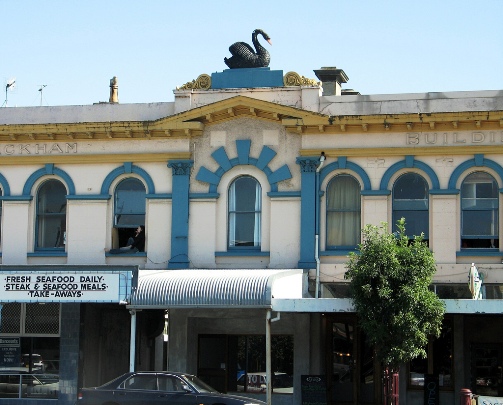The White Swan Hotel (Former), designed by prominent Invercargill architect F.W. Burwell for hotelier Richard Blackham in 1880, served as a hotel until 1906 when ‘No License’ made Invercargill dry. With its Victorian round-headed windows and interesting architectural detailing (including a swan atop its central pediment) the building has a strong presence on Dee Street. The White Swan Hotel has architectural, historical and aesthetic significance. English-born Richard Blackham came to New Zealand in the mid-1870s. He moved to Invercargill to take up the management of the Caledonian Hotel. Blackham became the hotel keeper at the harp of Erin hotel in Dee Street in the 1870s. On his license application, counsel pointed out that there were objections that Blackham was single and ‘that his character was unknown to the police.’ Blackham’s counsel thought ‘the second objection highly complimentary to Blackham.’ In the later 1870s, Blackham held the license for the Red Lion Hotel. The state of the premises was such that in 1879 the Licensing Committee refused Blackham’s application and warned ‘that some improvements would require to be effected before the annual licensing day in June next.’ In June 1880 the chair of the Licensing Committee warned Blackham that the renewal of his license was in jeopardy, and that he would be best to rebuild. In August 1880, architect Frederick Burwell invited tenders for ‘the erection of Hotel (concrete and brick) in Dee Street for Mr R. Blackham.’ Scottish-born Burwell, related to Dunedin architect David Ross through his mother, brought ‘a new level of cosmopolitanism to the Invercargill streetscape.’ Design historian Michael Findlay writes the Burwell filled Invercargill’s wide streets ‘with highly disciplined rows of two- and three-storey shops, banks and financial buildings’ using the ‘architectural language of international commerce of this period. His typical details included ‘round-headed windows at the upper level under projecting cornices and richly detailed balustrades.’ The hotel was one of a number of buildings gracing Dee and Tay streets, giving the town a grand appearance. The Southland Times reported that in the course of the ‘last two years there have been completed or are now in hand in Dee and Tay streets and others abutting on them, permanent brick buildings for public and business purposes to the extent of 1400 feet [427 metres] of frontage. The majority of these buildings are of such a character, architecturally, as would do credit to any city, and must be eye-openers to strangers who have looked upon us as a benighted people on the borders of the Ultima Thule [beyond the boundaries of the known world] of civilization in the Southern hemisphere.’ Blackham’s hotel was unfinished In September 1880 when he applied for a general license. His application was refused as the ‘house was not nearly completed.’ A second application in December 1880 was also refused on the same grounds. Blackham’s general license was granted on 7 March 1881. When the White Swan Hotel’s license was terminated as a result of the vote for reduction in Invercargill in 1903, Blackham recalled that the license originally belonged to one of J.A. Hanan’s buildings, run as the Harp of Erin, changed to the Red Lion when Blackham took over. When the license was refused Blackham bought the land on Dee Street (for £1050) and spent £2000 erecting the White Swan. Blackham was philosophical saying that he would ‘put crepe on the Swan after the 30th of the month.’ He also pointed out that the stabling, which on average provided accommodation for 16 horses and drays every Saturday, was still available. The final day of the license was commemorated by a gathering attended by Blackham’s friends, ‘[c]oursing men, pigeon and poultry fanciers, and those interested in sport’ who had for many years ‘made the White Swan their resort and they now came from far and near to be present at the gathering.’ Blackham was given a reprieve when a nearby license holder from the Crescent Hotel wanted to cancel their license and Blackham was able to apply for a license for the White Swan, which was granted subject to improvements to the building. In 1906, no License was carried and the White Swan became a boarding house. Invercargill remained dry until 1944. By 1906, Mrs Elizabeth Blackham was running the White Swan as an ‘up-to-date boarding house. Farmers and others know of old the liberal bill-of-fare Mrs Blackham has been in the habit of supplying, and will find the charges very reasonable. Permanent boarders will find all the comforts of a well-appointed home.’ Richard Blackham died in October 1912. The White Swan was run as a private hotel until around 1920, after which it seems to have housed other businesses including estate agents, hairdressers, a motor garage, outfitters and the like, and became known as Blackham’s Building. In 2017, the former White Swan Hotel continues to house small retail premises.

Location
List Entry Information
Overview
Detailed List Entry
Status
Listed
List Entry Status
Historic Place Category 2
Access
Private/No Public Access
List Number
2444
Date Entered
11th November 1983
Date of Effect
11th November 1983
City/District Council
Invercargill City
Region
Southland Region
Extent of List Entry
Extent includes the land described as Lots 1-2 DP 8785(RT SL4A/1354) and Lots 3, 6 DP 2931 (RT SL140/70), Southland Land District, and the buildings associated with White Swan Hotel (Former), thereon.
Legal description
Lots 1-2 DP 8785(RT SL4A/1354) and Lots 3, 6 DP 2931 (RT SL140/70), Southland Land District
Stay up to date with Heritage this month
